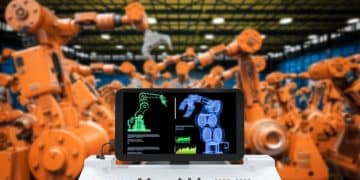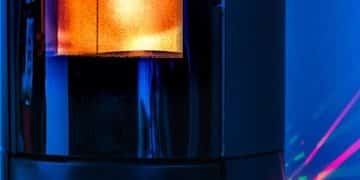How the Internet of Things (IoT) is Revolutionizing US Smart Homes
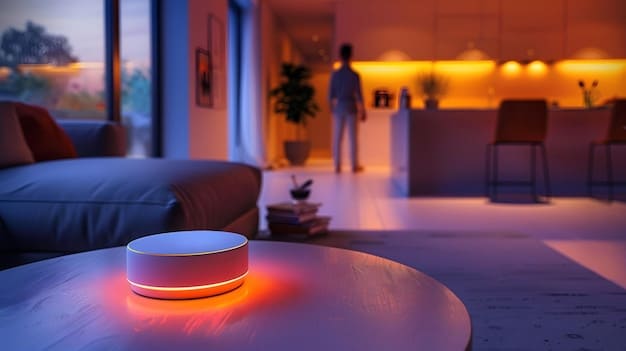
The Internet of Things (IoT) is fundamentally reshaping US smart homes by enabling seamless connectivity and advanced automation of devices, offering unprecedented levels of convenience, energy efficiency, and security.
The landscape of modern living is undergoing a profound transformation, and at its heart lies a technology that’s redefining convenience, efficiency, and security: the Internet of Things (IoT). But exactly how is the Internet of Things (IoT) revolutionizing US smart homes? This question opens a door to a fascinating world where everyday objects communicate, learn, and adapt, creating an interconnected ecosystem designed to simplify our lives.
The foundational shift: from isolated devices to integrated ecosystems
The concept of a “smart home” has evolved dramatically over the past decade, moving beyond individual smart gadgets to embrace fully integrated ecosystems. This shift is powered by the IoT, which facilitates communication and collaboration among devices that were once standalone. It’s not just about turning lights on with your phone; it’s about a symphony of devices working in concert to create a more intuitive living experience.
Early iterations of smart home technology often relied on proprietary systems that limited interoperability. However, the maturation of IoT standards and platforms has fostered a more open environment, allowing devices from different manufacturers to communicate effectively. This convergence is crucial for the widespread adoption and true utility of smart home technology in the US. The ability for a smart doorbell to trigger a security camera recording or for a smart lock to integrate with an alarm system exemplifies this powerful interconnectedness.
Seamless connectivity and control
One of the most obvious ways IoT is transforming US smart homes is through pervasive connectivity. Wireless technologies like Wi-Fi, Bluetooth, Zigbee, and Z-Wave form the backbone of these interconnected environments, allowing devices to communicate with each other and with central hubs or cloud platforms. This connectivity enables remote monitoring and control, putting unprecedented power into the hands of homeowners.
- Remote Access: Adjust thermostat settings, check security camera feeds, or lock doors from anywhere in the world using a smartphone app.
- Voice Control: Integrate devices with virtual assistants like Amazon Alexa or Google Assistant for hands-free operation.
- Automated Routines: Set up schedules and triggers for lights, HVAC, and entertainment systems based on time, presence, or other sensor inputs.
Enhanced convenience and comfort
The primary draw of smart home technology, for many, is the enhanced convenience it offers. Imagine waking up to lights gently brightening, the coffee maker brewing, and the thermostat adjusting to your preferred temperature, all without lifting a finger. This level of automation, driven by IoT, aims to simplify daily routines and elevate comfort. Personalized experiences are becoming the norm, with homes anticipating needs rather than merely reacting to commands. This foresight is a direct result of IoT devices gathering and analyzing data about homeowner habits and preferences.
The integration of smart appliances, such as refrigerators that track inventory and suggest recipes, or washing machines that optimize cycles based on fabric type, takes mundane household tasks into the realm of effortless living. This liberation from routine chores allows residents to reclaim valuable time and focus on more meaningful activities. The continuous refinement of algorithms combined with increasing device sophistication means these capabilities will only grow more impressive.
Smart security and safety: A new paradigm
Beyond convenience, IoT is revolutionizing smart homes by bolstering security and safety measures, providing homeowners with greater peace of mind. Traditional security systems are being augmented and, in some cases, replaced by more intelligent, interconnected solutions. These systems offer real-time monitoring, alerts, and even proactive measures to protect property and occupants. The integration of various sensors and alerts creates a comprehensive safety net.
Smart doorbells with built-in cameras and two-way audio allow homeowners to see and speak with visitors from anywhere, deterring potential intruders. Smart locks enable remote access control and can even generate temporary passcodes for guests or service providers, eliminating the need for physical keys. Beyond entry points, smart security cameras with motion detection and facial recognition capabilities offer continuous surveillance, sending alerts in the event of unusual activity.
Proactive safety measures
IoT extends beyond security to encompass proactive safety measures within the home. Smart smoke detectors that not only alert occupants but also notify emergency services or unlock doors for easier escape represent a significant leap forward. Similarly, smart carbon monoxide detectors provide early warnings, and smart water leak sensors can prevent costly damage by detecting leaks and even shutting off the main water supply automatically.
The ability for these devices to communicate means a multi-faceted response to emergencies. For instance, if a smoke alarm is triggered, smart lights could flash, smart shades could open, and internal doors could unlock, aiding in a swift and safe evacuation. This level of coordinated response, previously impossible, highlights the transformative power of IoT in ensuring household safety. Predictive analytics, based on various sensor inputs, could even forecast potential issues before they escalate, such as identifying a faulty appliance drawing excessive power.
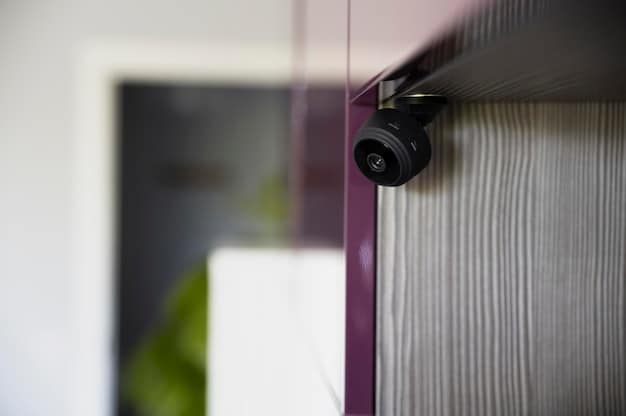
Energy efficiency and sustainability gains
As awareness of climate change and energy costs grows, IoT is playing a pivotal role in making US smart homes more energy-efficient and sustainable. Smart thermostats are perhaps the most common example, learning household patterns and adjusting heating and cooling to optimize energy consumption. These devices can integrate with weather forecasts, occupancy sensors, and even utility peak-pricing information to save users money and reduce their carbon footprint.
Beyond thermostats, smart lighting systems offer granular control over illumination, allowing users to dim lights, set schedules, and even adjust color temperatures based on natural light levels. Occupancy sensors ensure lights are only on when a room is in use, while daylight harvesting sensors automatically adjust artificial lighting based on natural light availability. This precise control significantly reduces wasted energy.
Optimizing resource consumption
IoT-enabled smart plugs allow homeowners to monitor the energy consumption of individual appliances and even remotely power them off, eliminating “vampire drain” from devices on standby. Smart irrigation systems, another example, use local weather data, soil moisture sensors, and plant-specific requirements to water lawns and gardens only when necessary, conserving precious water resources.
The aggregation of data from various smart home devices provides homeowners with actionable insights into their energy and water usage. Dashboards and reports highlight areas of potential savings, empowering users to make more informed decisions about their consumption habits. This real-time feedback loop is instrumental in fostering sustainable living practices at a household level, contributing to broader environmental goals. The ongoing development of energy management systems will further integrate renewable energy sources, allowing smart homes to become even more self-sufficient.
Accessibility and assistive technologies
The revolutionary impact of IoT on US smart homes extends significantly into the realm of accessibility and assistive technologies, profoundly improving the quality of life for individuals with disabilities or limited mobility. Smart home devices offer a new level of independence and autonomy, allowing people to manage their living environments with greater ease and less physical effort. This transformation is not just about convenience; it is about empowerment.
For individuals with mobility challenges, voice-controlled lighting, thermostats, and entertainment systems eliminate the need to physically interact with switches or buttons. Automatic door openers and smart locks can be operated remotely or through voice commands, making entry and exit seamless. These advancements break down physical barriers that once necessitated constant assistance, fostering a sense of self-reliance. The customization options available in most smart home platforms allow for tailoring solutions to specific individual needs, making them truly personal.
Tailored solutions for special needs
Beyond basic controls, IoT offers more sophisticated assistive features. Smart beds can adjust positions to alleviate pressure points or assist with getting into and out of bed. Smart medication dispensers ensure timely and correct dosages, sending reminders to users and caregivers. Fall detection sensors, often integrated into wearable devices or cameras, can automatically alert emergency contacts if an incident occurs, providing a critical layer of safety for the elderly or those prone to falls.
The integration of AI and machine learning within IoT systems further refines these assistive capabilities. For example, systems can learn an individual’s daily routine and proactively adjust the environment, turning on lights before they enter a room or adjusting blinds to minimize glare. This proactive assistance reduces a significant cognitive load, allowing users to focus on other aspects of their lives. The continuous advancement in sensor technology promises even more nuanced and responsive assistive features in the future, further blurring the lines between technology and care.
Challenges and the path forward
Despite the widespread adoption and clear benefits, the IoT revolution in US smart homes is not without its challenges. Addressing these issues is crucial for sustained growth and widespread consumer trust. Privacy concerns, cybersecurity risks, and interoperability issues remain significant hurdles that industry stakeholders and policymakers are actively working to overcome. These challenges, while complex, are not insurmountable and represent areas of intense innovation.
The sheer volume of data collected by smart home devices, from daily routines to voice commands and video feeds, raises legitimate privacy concerns. Ensuring this data is securely stored, used ethically, and protected from breaches is paramount. Consumers need assurances that their personal information will not be misused or fall into the wrong hands. Clear privacy policies and robust data encryption are essential for building and maintaining consumer trust. Many companies are now opting for edge computing, processing data locally to minimize cloud exposure.
Overcoming technological hurdles
Cybersecurity is another critical challenge. Every connected device represents a potential entry point for malicious actors. Weak default passwords, unpatched vulnerabilities, and insecure network configurations can expose an entire smart home ecosystem to risks. Manufacturers are increasingly implementing stricter security protocols, frequent firmware updates, and bug bounty programs to identify and rectify vulnerabilities proactively. However, consumer education on best practices, such as strong password usage and network segmentation, also plays a vital role.
Interoperability, while improving, still presents friction. Consumers often find themselves navigating multiple apps and platforms from different manufacturers, leading to a fragmented user experience. Industry initiatives like Matter, a unified smart home connectivity standard, aim to simplify this by creating a common language that all compatible devices can speak. The widespread adoption of such standards is critical for a truly seamless and intuitive smart home experience. Continued investment in research and development will also address current limitations in sensor accuracy and communication reliability.
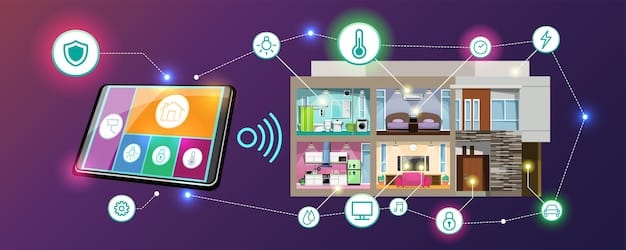
The economic impact and market trends
The IoT revolution in US smart homes isn’t just about technological advancement; it’s also a significant economic force, driving innovation, job creation, and substantial market growth. The sector continues to expand rapidly, attracting considerable investment and influencing consumer spending habits. Understanding these trends provides insight into the future trajectory of smart home technology and its broader societal implications. The market’s dynamism mirrors the rapid pace of technological development itself.
According to various market research reports, the US smart home market is projected to reach multi-billion dollar valuations in the coming years, with consistent double-digit growth rates. This growth is fueled by increasing consumer awareness, falling device costs, and the continuous introduction of new, more sophisticated products. Key drivers include the demand for energy efficiency, enhanced security, and the desire for convenient, technologically advanced lifestyles. This burgeoning market creates a fertile ground for both established tech giants and innovative startups.
Shifting consumer preferences and product evolution
Consumer preferences are evolving, moving beyond early adopters to a broader mainstream audience. While initial smart home purchases might be driven by single-purpose devices like smart speakers or thermostats, consumers are increasingly seeking integrated solutions that offer a cohesive experience. This shift encourages manufacturers to focus on ecosystem development and seamless integration across diverse product categories. The emphasis is now on creating intuitive user interfaces that simplify complex functionalities.
In response, product development is focusing on artificial intelligence (AI) and machine learning (ML) capabilities to make devices more proactive, personalized, and efficient. We are seeing a move towards “context-aware” homes that can anticipate needs based on learned behaviors, external data (like weather or traffic), and the presence of occupants. From personalized climate control to predictive maintenance for appliances, the next wave of smart home innovation will be characterized by greater intelligence and autonomy, further solidifying IoT’s transformative role. This signifies a maturation of the market, where utility and user experience take precedence.
| Key Aspect | Brief Description |
|---|---|
| 🏠 Integrated Ecosystems | IoT connects previously isolated devices into cohesive systems for unified control and automation. |
| 🔒 Enhanced Security | Smart locks, cameras, and sensors provide real-time monitoring and proactive safety measures. |
| ⚡ Energy Efficiency | Smart thermostats and lighting optimize consumption, reducing utility costs and environmental impact. |
| ♿ Improved Accessibility | Voice control and automated functions offer greater independence for individuals with mobility challenges. |
Frequently Asked Questions
In smart homes, IoT refers to the network of interconnected devices, appliances, and sensors that communicate with each other and with the internet. This connectivity allows for remote monitoring, control, and automation of various household functions, from lighting and climate to security and entertainment, all designed to enhance convenience and efficiency.
While security has been a concern, manufacturers are continually improving safeguards with stronger encryption, regular firmware updates, and improved authentication protocols. Users also play a crucial role by using strong, unique passwords, enabling two-factor authentication, and keeping their device software updated to mitigate potential cyber threats effectively.
IoT devices contribute to energy savings by allowing precise control and automation of energy-consuming systems. Smart thermostats learn occupant habits and adjust temperatures, smart lighting turns off when rooms are empty, and smart plugs monitor and cut power to devices on standby, collectively reducing overall energy consumption and utility bills significantly.
Yes, interoperability is improving significantly. While older devices might be proprietary, newer devices increasingly support common standards like Matter, Zigbee, Z-Wave, or integrate with major ecosystems such as Amazon Alexa, Google Home, and Apple HomeKit. This allows for a more cohesive smart home experience, enabling devices from various brands to work together seamlessly.
Future trends include greater integration of AI and machine learning for more proactive and personalized home environments that anticipate needs. Expect enhanced security features like advanced facial recognition, expanded health monitoring capabilities, and more robust energy management systems that integrate renewable sources, leading to increasingly autonomous and intelligent living spaces.
Conclusion
The Internet of Things has unequivocally revolutionized US smart homes, transforming them from mere collections of intelligent gadgets into sophisticated, integrated ecosystems. From enhancing daily convenience and comfort to fortifying security and championing energy efficiency, IoT is not just improving how we live, but redefining the very concept of a home. While challenges like privacy and interoperability persist, the continuous innovation, coupled with evolving standards, suggests a future where our homes are not just smarter, but truly intuitive, responsive, and seamlessly integrated into the fabric of our lives. The journey toward fully autonomous and context-aware homes is well underway, promising an era of unprecedented efficiency, safety, and personalized living.



